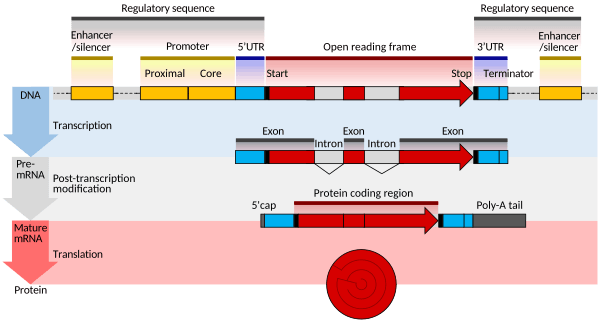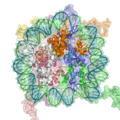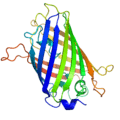Gene expression facts for kids
Gene expression is the process by which the heritable information in a gene, the sequence of DNA base pairs, is made into a functional gene product, such as protein or RNA. The basic idea is that DNA is transcribed into RNA, which is then translated into proteins. Proteins make many of the structures and all the enzymes in a cell or organism.
Several steps in the gene expression process may be modulated (tuned). This includes both the transcription and translation stages, and the final folded state of a protein. Gene regulation switches genes on and off, and so controls cell differentiation, and morphogenesis. Gene regulation may also serve as a basis for evolutionary change: control of the timing, location, and amount of gene expression can have a profound effect on the development of the organism.
The expression of a gene may vary a lot in different tissues. This is called pleiotropism, a widespread phenomenon in genetics.
Contents
Epigenetics
In biology, epigenetics is the study of inherited changes in phenotype (appearance) or gene expression caused by mechanisms other than changes in the underlying DNA sequence.
These changes may remain through cell divisions for the remainder of the individual's life and may also last for multiple generations. However, there is no change in the underlying DNA sequence of the organism. Instead, non-genetic factors cause the organism's genes to behave (express themselves) differently.
The best example of epigenetic changes in eukaryote biology is the process of cellular differentiation. During morphogenesis, totipotent stem cells become the various cell lines of the embryo, which in turn become fully differentiated cells. In other words, a single fertilized egg cell – the zygote – divides and develops. The daughter cells change into the many cell types of the mature embryo. These include neurones, muscle cells, epithelium, blood vessels an so on. This happens by activating some genes while inhibiting others.
Epigenetic changes are long-term, and usually survive the process of cell division (mitosis). Changes occur in the chromatin, which is a combination of the DNA and its surrounding histone proteins in the chromosome. The details of how this happens are still being worked out, but it is fairly certain that the wrapping of the DNA and histone is a key feature.
Gene regulation
Up-regulation and down-regulation
Up-regulation increases the expression of one or more genes and as a result the protein(s) encoded by those genes. Down-regulation is a process resulting in decreased gene and protein expression.
Induction vs repression
Gene regulation can be summarized as:
- Inducible systems: an inducible system is off unless there is the presence of some molecule (called an inducer) that allows for gene expression.
- Repressible systems: a repressible system is on except in the presence of some molecule (called a corepressor) that suppresses gene activity. The molecule is said to repress expression.
Regulatory RNAs
There are a number of RNAs which regulate genes, that is, they regulate the rate at which genes are transcribed or translated. The following are two important examples
miRNA
Micro RNAs (miRNA) act by joining an enzyme and blocking mRNA (messenger RNA), or speeding its breakdown. This is called RNA interference.
siRNA
Small interfering RNAs (sometimes called silencing RNAs) interfere with the expression of a specific gene. They are quite small (20/25 nucleotides) double-stranded molecules. Their discovery has caused a surge in biomedical research and drug development.
Related pages
Images for kids
-
The extended central dogma of molecular biology includes all the cellular processes involved in the flow of genetic information
-
The patchy colours of a tortoiseshell cat are the result of different levels of expression of pigmentation genes in different areas of the skin.
-
The lambda repressor transcription factor (green) binds as a dimer to major groove of DNA target (red and blue) and disables initiation of transcription. From PDB 1LMB.
-
In eukaryotes, DNA is organized in form of nucleosomes. Note how the DNA (blue and green) is tightly wrapped around the protein core made of histone octamer (ribbon coils), restricting access to the DNA. From PDB 1KX5.
-
Regulation of transcription in mammals. An active enhancer regulatory region is enabled to interact with the promoter region of its target gene by formation of a chromosome loop. This can initiate messenger RNA (mRNA) synthesis by RNA polymerase II (RNAP II) bound to the promoter at the transcription start site of the gene. The loop is stabilized by one architectural protein anchored to the enhancer and one anchored to the promoter and these proteins are joined to form a dimer (red zigzags). Specific regulatory transcription factors bind to DNA sequence motifs on the enhancer. General transcription factors bind to the promoter. When a transcription factor is activated by a signal (here indicated as phosphorylation shown by a small red star on a transcription factor on the enhancer) the enhancer is activated and can now activate its target promoter. The active enhancer is transcribed on each strand of DNA in opposite directions by bound RNAP IIs. Mediator (a complex consisting of about 26 proteins in an interacting structure) communicates regulatory signals from the enhancer DNA-bound transcription factors to the promoter.
-
In situ-hybridization of Drosophila embryos at different developmental stages for the mRNA responsible for the expression of hunchback. High intensity of blue color marks places with high hunchback mRNA quantity.
-
The three-dimensional structure of green fluorescent protein. The residues in the centre of the "barrel" are responsible for production of green light after exposing to higher energetic blue light. From PDB 1EMA.
See also
 In Spanish: Expresión génica para niños
In Spanish: Expresión génica para niños













